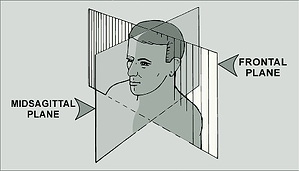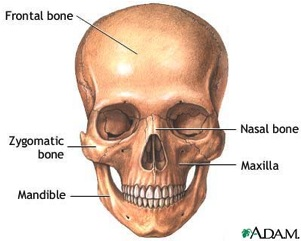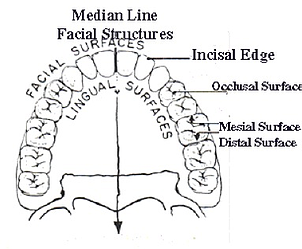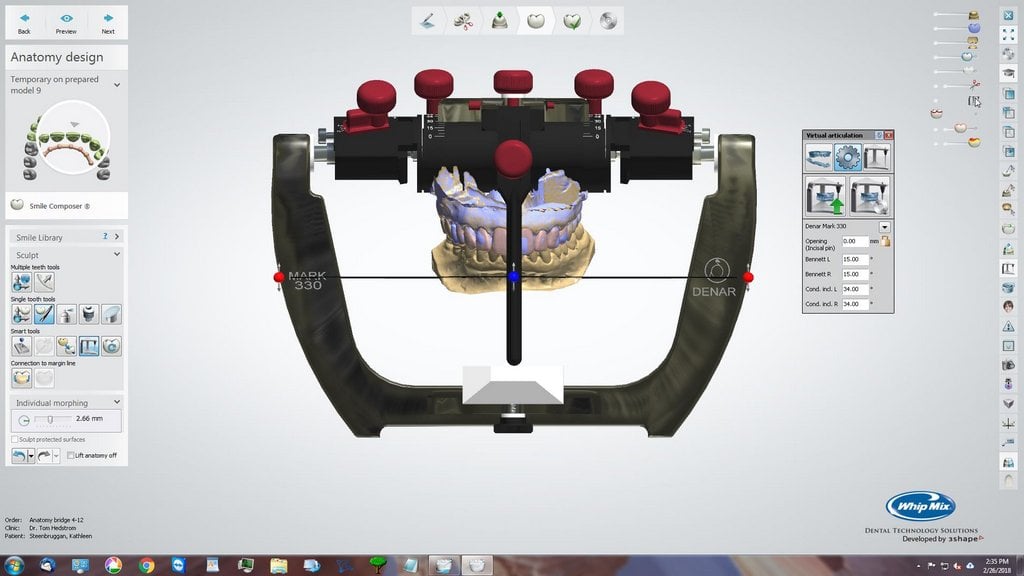Dentistry has a common language, and it is important that Technicians, Dentists, Dental Assistants & Hygienists are all speaking the same language. If you cannot speak and write in this common language, then you cannot communicate in our industry.
Depending on where dentists go to school, there will be different names or terms for different structures, so it is important for dental technicians to be fluent in all the terms and then relate that to your individual dentist. Make sure you are able to capture that information, as well as communicate back using the same terms.
I have broken-up the most common terms you need to know into four sections: Planes, Positions, Structures & Directions. Lets begin...
 Planes
Planes
Plane of Occlusion - that plane which is described by the relationship between the upper and lower teeth when they are together in a natural bite. Planes are the flat section defined by at least three (3) points in space. The body and teeth are divided into various planes. For our purpose, we will be focusing on the head, neck and face.
Curve of Spee - the curve, which extends from anterior to posterior on each side of the arch
Curve of Wilson - the curve, which extends from one side of the mouth to the other, and follows the natural inclination of the teeth toward the tongue.
Sphere of Monson - the sphere described by the combining of the Curve of Wilson and the Curve of Spee forming a shape roughly the size of a tennis ball.
Bonwill - an equilateral triangle with 4-in (10 cm) sides bounded by lines from the contact points of the lower central incisors (or the median line of the residual ridge of the manibular) to the condyle on either side and from one condyle to the other. It is the basis for Bonwill's theory of occlusion.
Frankfort Horizontal Plane - also known as the axis orbital plane. The horizontal plane is established by the transverse horizontal axis of the mandible with a point on the inferior border of the right or left bony orbit (ortibtale). This plane can be used as a horizontal reference point and is the plane most face-bow's use to begin measurement.
Face-bow Registration - the face-bow registration uses the Frankfort Horizontal Plane, the bitefork then registers the occlusal table in relationship to the Frankfort Plane.
Positions
Maximal Intercuspation (MI) - occurs when the jaws are closed in a position that produces maximal stable contact between the occluding surfaces of the maxillary and mandibular teeth.
Centric Occlusion (CO) - refers to the relationship of the mandible to the maxilla when the teeth are in MI (Maximum Intercuspation) irrespective of the position or alignment of the Condylar Disc assemblies. This is also referred to as Acquired Centric.
Centric Relation (CR) - is the relationship of the Mandible to the Maxilla with properly aligned condyle-disc assembly in the most SUPERIOR (highest) position against the eminentia, irrespective of tooth position or vertical dimension.
Structures (Anatomy of the Mouth)
Maxilla - the part of the skull, which supports the upper teeth and palate, and is under the nasal sinus.
Mandible - also know as the "JAW". This is the lower member of the oral cavity, which is the portion that moves when chewing.
Palate - comprised of two parts: the 'SOFT' and the 'HARD'. The palate is the "UPPER" part of the oral cavity, this is the part of the mouth which is opposite of the Mandible.
Temporomandibular Joint (TMJ) - this is the joint where the Maxilla and the Mandible tie together. This is also the site where the condyle 'rotates' and 'translates' which are two primary movements.
TMJ Disorders - disorders in the TMJ may cause issue with: headaches, migraines, abnormal tooth wear, masticatory discomfort, speech irregularities & continuous pain
Directions
When we talk about directions we are referring to the position of something.
Anterior - toward the front. This is the position of anything that is toward the face in relation to another surface or structure. Every tooth has an anterior surface. In a posterior tooth the Mesial side is the Anterior to the distal side.
Posterior - toward the back. This is the position of anything that is toward the back of the mouth or head. In teeth, it is the Bi-Cuspids or Pre-Molars and Molars.
Mesial - toward the median line. This is the surface that is closest to the median line. Each tooth has a mesial surface.
Distal - away from the median line. This is the surface, which is the most DISTant from the median line.
Occlusal - the surface that comes into 'occlusion' or contact with the opposing dentition, the 'top' surface of the teeth. Generally applied to the posterior teeth.
Lingual - the surface closest to the tongue.
Palatal - the surface of the upper teeth closest to the palate. This surface is often referred to as 'LINGUAL'.
Buccal - the side of the tooth closest to the Buccinator Muscle, the "outside" surface of the posterior teeth.
Facial/Labial - that side which is closest to the face or the lips. Generally used for the 'front' of anterior teeth. Both of these terms can be used interchangeably.
Lateral - meaning to the side of. Most surfaces can be a 'lateral' surface when referenced to another surface, however, in general we are talking about the sides of and object when facing it.
Long Axis - a line running the vertical length of the tooth.
Anterior Landmarks - are found on all anterior teeth and lower.
Posterior Occlusal Landmarks - all of these posterior landmarks aid in mastication, and are present singly or in combination on all posterior teeth.
Once you know and understand these terms you can begin to improve the communication between your lab and the dental office.











.png)

Leave a comment